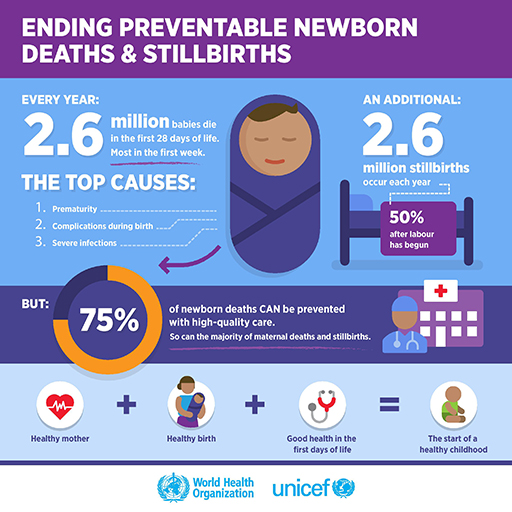2.1 Maternal and infant mortality
WHO and UNICEF’s continuing global drive to reduce the numbers of mothers and children dying at or around the time of birth is called ‘Every newborn’. The UNICEF inforgraphic in Figure 3 shows the number of preventable stillborns and newborn deaths.
Below is an extract from the executive summary of the ‘Every newborn’ report.
3 million babies and women could be saved each year through investing in quality care around the time of birth and special care for sick and small newborns. Cost-effective solutions are now available to protect women and children from the most dangerous day of their lives – the day of birth.
Unfinished agenda: Newborn health and stillbirths are part of the ‘unfinished agenda’ of the Millennium Development Goals for women’s and children’s health. With newborn deaths still accounting for 44% of under-5 deaths globally, newborn mortality and stillbirths require greater visibility in the emerging post-2015 sustainable development agenda if the overall under-5 mortality is to be reduced.
We have solutions to address the main causes of newborn death: More than 80% of all newborn deaths result from three preventable and treatable conditions – complications due to prematurity, intrapartum-related deaths (including birth asphyxia) and neonatal infections. Cost-effective, proven interventions exist to prevent and treat each main cause. Improving quality of care around the time of birth will save the most lives, but this requires educated and equipped health workers, including those with midwifery skills, and availability of essential commodities.
Women’s and children’s health is a smart investment, particularly with specific attention to care at birth: High coverage of care around the time of birth and care of small and sick newborns would save nearly 3 million lives (women, newborns and stillbirths) each year at an additional running cost of only US$ 1.15 per person in 75 high burden countries. This would have a triple impact on investments – saving women and newborns and preventing stillbirths.
You have already explored some of the issues discussed in the executive summary in Week 1. For example, you looked at health and educational inequalities. Perhaps the main thing to take away from this summary is that so much can be done in the earliest years of life to address the most fundamental of inequalities: who survives infancy and childhood.
In the next section, you will read some recent analysis on maternal and infant mortality rates from the organisation Save the Children.

